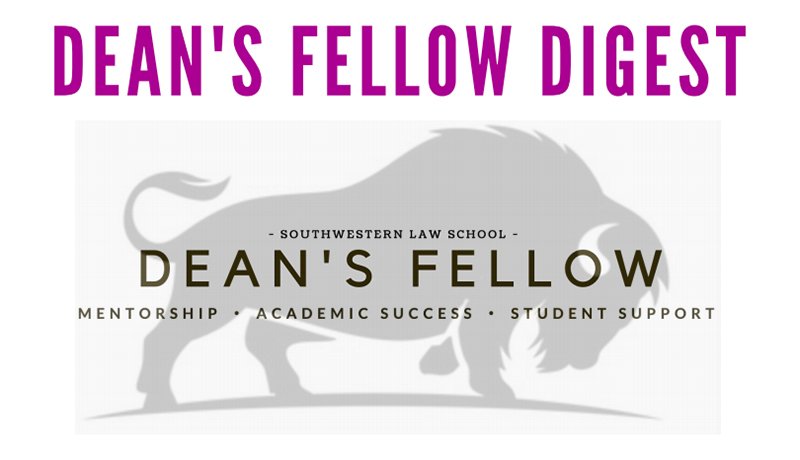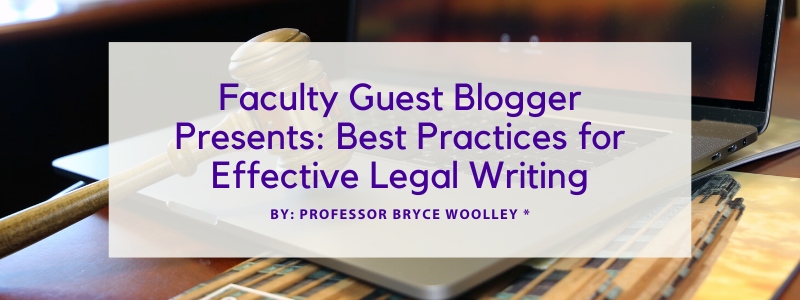SWLAW Blog | Dean's Fellow Digest

October 8, 2021
Dean's Fellow Digest Issue #32 - Faculty Guest Blogger Presents: Best Practices for Effective Legal Writing
Issue: 2021-10-8
Dean's Fellows consistently strive to support students in realizing their full academic potential, leading ultimately to success on the bar exam and in the workplace. To support all Southwestern students in this goal, the Dean's Fellows created this Digest as a way to check-in at critical times throughout the semester with helpful tips, strategies, and encouragement.
IN THIS ISSUE:
-
Faculty Guest Blogger Presents: Best Practices for Effective Legal Writing

Legal writing is different from what you are used to so you will have to adapt. You might be used to flowery, complex writing from academia. Or sensational, simplified writing from journalism. Effective legal writing should be direct and focused. For creative prose and poetry – you do you! Those are free-for-alls, like grand jury proceedings. This is about best practices for clear, direct writing and not meant to replace what you are learning in your LAWS class.
Brevity is a virtue. Motions and briefs submitted to the court have page limits and sometimes word limits. In California, a demurrer is limited to 15 pages. Replies are limited to 10. Directness and concision are key to effective legal writing and compliance with court rules. This starts with how you structure sentences. My mantra is “Short. Declarative. Sentences.”
Overly complicated writing is the enemy of effective legal writing and has many minions. Some of the worst are:
Long sentences. Long sentences cram multiple points into one sentence at the expense of clarity and persuasive force. They are harder for the reader to follow and understand your argument and conclusion. If your sentence is composed of numerous clauses, consider if each clause can be a standalone sentence. Delete redundant clauses or asides. I emphatically recommend using creative adjectives and superfluous adverbs sparingly. I mean, use adjectives and adverbs sparingly. Law is complex so figuring out how to communicate that complexity in short sentences is a skill.
Elegant variation is using a variety of words to describe the same thing. This invites the reader to see distinctions where you may not intend to distinguish. You should use the same word even if it feels redundant. Especially for legal terms of art.
Passive voice is when the subject of a sentence is acted upon. It is wordier and less precise than active voice. It can be appropriate when causation is unclear or strategically deployed when you want to make causation ambiguous. Endeavor to structure your sentences in the order of subject -> verb -> object to avoid passive voice.
Compound constructions and idioms. Compound constructions use three or four words to do the work of one or two. They make your writing needlessly long and complex, usually at the expense of directness and clarity. Some of the most common compound constructions found in student legal writing are “in order to” and “in the event that.” Replace these with “to” and “if.” Idioms are common expressions that add unnecessary words. Some of the most common idioms are “because of the fact that” and “at this point in time.” Replace these with “because” and “now.” Some idioms you can delete entirely when they don’t add any substance to your writing.
Nominalizations. A nominalization is a base verb turned into a noun. Base verb “state” becomes nominalization “make a statement.” “Act” becomes “take action.” “Assume” becomes “make assumptions.” Nominalizations introduce surplus words. Effective legal writing should avoid surplus words because they add unnecessary length and do nothing for clarity.
***
The following is an example based on Anjou v. Boston Elevated Railway Co., 208 Mass. 273, 94 N.E. 386 (1911), a torts case where the plaintiff sued for injuries after slipping on a banana peel. Here is a paragraph of student analysis that could be improved:
- The facts show that the plaintiff slipped on a banana peel that was very gritty. It can be argued that the dirtiness shows negligence because an employee, or someone working for the railway company, should have swept or cleaned the platform but the dirtiness shows that they didn’t which shows a breach of duty. Railway operators should have their employees clean the platforms regularly enough so that a banana peel doesn’t get this gritty.
Here is a better paragraph:
- The plaintiff slipped on a gritty banana peel. The gritty condition of the banana peel showed that the defendant was negligent because a reasonable railway operator would require its employees to regularly sweep its platforms. A banana peel would not be that gritty unless the railway’s employees had not swept for an unreasonable amount of time.
The second paragraph is easier to understand and is 18 words shorter. Both paragraphs make the same point and use the same facts, but the second is easier to understand because it does not use a long run-on sentence and avoids an unnecessary surplus of words. Here are the problems with the first paragraph:
The facts show that [idiom] the plaintiff slipped on a banana peel that was very gritty. It can be argued that [idiom] the dirtiness [elegant variation] shows negligence because an employee, or someone working for the railway company [redundant], should have swept or cleaned [redundant] the platform but the dirtiness shows that they didn’t which shows a breach of duty [long sentence]. Railway operators should have their employees clean the platforms regularly enough so that a banana peel doesn’t get this gritty.
* * *
Adjusting to legal writing is hard. Implementing these best practices will streamline your writing and facilitate the adjustment. It will take a lot of practice. As the idiom – an acceptable one! – goes: “practice makes perfect!”
*About the Authors:

Professor Woolley is passionate about helping his students pass the bar exam. His teaching focuses on heavily-tested bar topics and skills for the written portion of the bar exam, ranging from criminal law and procedure to legal ethics. His nonprofit work focuses on connecting people impacted by incarceration with healthcare education and services. Prior to joining Southwestern, he worked as an associate for large, medium, and small law firms practicing complex commercial, healthcare, and professional liability litigation.
Woolley received his J.D. from UCLA School of Law, where he was Editor-in-Chief of the Dukeminier Awards Journal of Sexual Orientation and Gender Identity Law and a Moot Court Honors Program Distinguished Advocate. He received his B.A., summa cum laude, from UC San Diego, in Sociology and Law & Society.
Southwestern Law School Dean's Fellows | Scheduling and Booking Website
Dean’s Fellows are upper-division students with strong academic skills who go through a rigorous application and training process. They are an integral part of the Academic Success and Bar Preparation Department. They are carefully selected based on their academic excellence and ability to teach other students best-practice study methods that will help them become acclimated to the study of law. Dean’s Fellows meet with students as academic mentors.
Please click HERE to make an appointment with a Dean's Fellow.